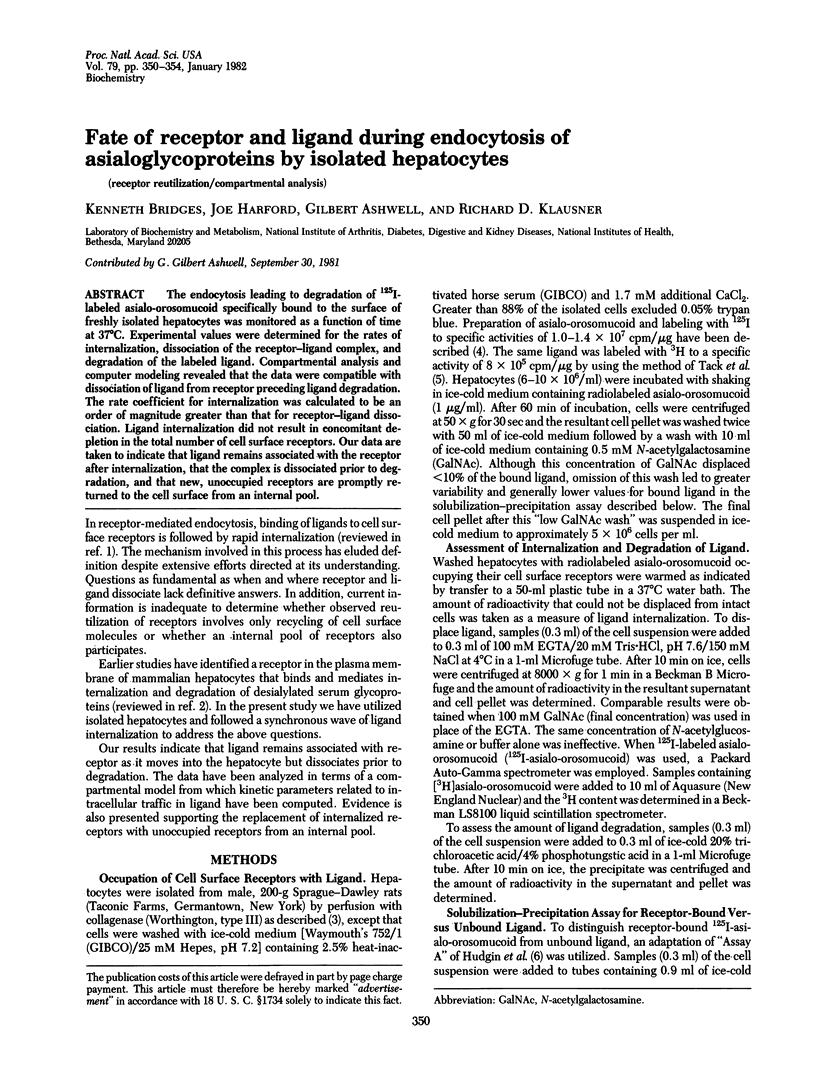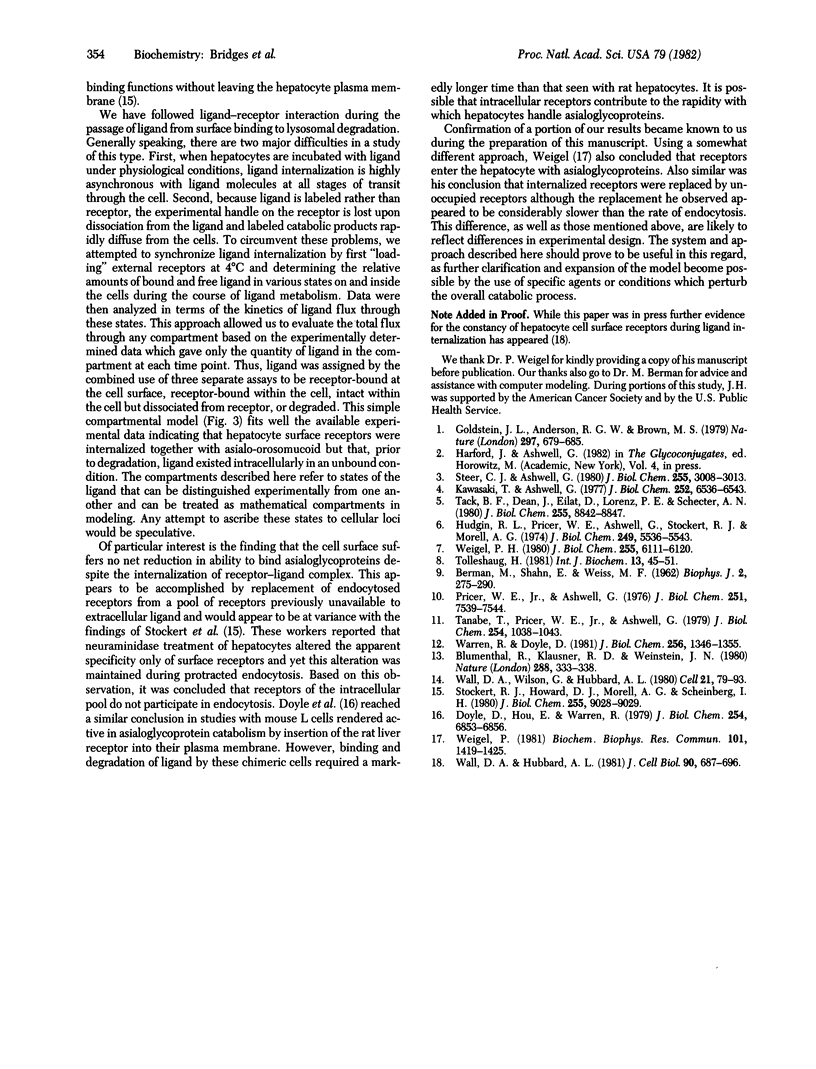Abstract
The endocytosis leading to degradation of 125I-labeled asialo-orosomucoid specifically bound to the surface of freshly isolated hepatocytes was monitored as a function of time at 37 degrees C. Experimental values were determined for the rates of internalization, dissociation of the receptor-ligand complex, and degradation of the labeled ligand. Compartmental analysis and computer modeling revealed that the data were compatible with dissociation of ligand from receptor preceding ligand degradation. The rate coefficient for internalization was calculated to be an order of magnitude greater than that for receptor--ligand dissociation. Ligand internalization did not result in concomitant depletion in the total number of cell surface receptors. Our data are taken to indicate that ligand remains associated with the receptor after internalization, that the complex is dissociated prior to degradation, and that new, unoccupied receptors are promptly returned to the cell surface from an internal pool.
Full text
PDF




Selected References
These references are in PubMed. This may not be the complete list of references from this article.
- BERMAN M., SHAHN E., WEISS M. F. The routine fitting of kinetic data to models: a mathematical formalism for digital computers. Biophys J. 1962 May;2:275–287. doi: 10.1016/s0006-3495(62)86855-6. [DOI] [PMC free article] [PubMed] [Google Scholar]
- Blumenthal R., Klausner R. D., Weinstein J. N. Voltage-dependent translocation of the asialoglycoprotein receptor across lipid membranes. Nature. 1980 Nov 27;288(5789):333–338. doi: 10.1038/288333a0. [DOI] [PubMed] [Google Scholar]
- Doyle D., Hou E., Warren R. Transfer of the hepatocyte receptor for serum asialo-glycoproteins to the plasma membrane of a fibroblast. Acquisition of the hepatocyte receptor functions by mouse L-cells. J Biol Chem. 1979 Aug 10;254(15):6853–6856. [PubMed] [Google Scholar]
- Goldstein J. L., Anderson R. G., Brown M. S. Coated pits, coated vesicles, and receptor-mediated endocytosis. Nature. 1979 Jun 21;279(5715):679–685. doi: 10.1038/279679a0. [DOI] [PubMed] [Google Scholar]
- Hudgin R. L., Pricer W. E., Jr, Ashwell G., Stockert R. J., Morell A. G. The isolation and properties of a rabbit liver binding protein specific for asialoglycoproteins. J Biol Chem. 1974 Sep 10;249(17):5536–5543. [PubMed] [Google Scholar]
- Kawasaki T., Ashwell G. Isolation and characterization of an avian hepatic binding protein specific for N-acetylglucosamine-terminated glycoproteins. J Biol Chem. 1977 Sep 25;252(18):6536–6543. [PubMed] [Google Scholar]
- Pricer W. E., Jr, Ashwell G. Subcellular distribution of a mammalian hepatic binding protein specific for asialoglycoproteins. J Biol Chem. 1976 Dec 10;251(23):7539–7544. [PubMed] [Google Scholar]
- Steer C. J., Ashwell G. Studies on a mammalian hepatic binding protein specific for asialoglycoproteins. Evidence for receptor recycling in isolated rat hepatocytes. J Biol Chem. 1980 Apr 10;255(7):3008–3013. [PubMed] [Google Scholar]
- Stockert R. J., Howard D. J., Morell A. G., Scheinberg I. H. Functional segregation of hepatic receptors for asialoglycoproteins during endocytosis. J Biol Chem. 1980 Oct 10;255(19):9028–9029. [PubMed] [Google Scholar]
- Tack B. F., Dean J., Eilat D., Lorenz P. E., Schechter A. N. Tritium labeling of proteins to high specific radioactivity by reduction methylation. J Biol Chem. 1980 Sep 25;255(18):8842–8847. [PubMed] [Google Scholar]
- Tanabe T., Pricer W. E., Jr, Ashwell G. Subcellular membrane topology and turnover of a rat hepatic binding protein specific for asialoglycoproteins. J Biol Chem. 1979 Feb 25;254(4):1038–1043. [PubMed] [Google Scholar]
- Tolleshaug H. Binding and internalization of asialo-glycoproteins by isolated rat hepatocytes. Int J Biochem. 1981;13(1):45–51. doi: 10.1016/0020-711x(81)90135-x. [DOI] [PubMed] [Google Scholar]
- Wall D. A., Hubbard A. L. Galactose-specific recognition system of mammalian liver: receptor distribution on the hepatocyte cell surface. J Cell Biol. 1981 Sep;90(3):687–696. doi: 10.1083/jcb.90.3.687. [DOI] [PMC free article] [PubMed] [Google Scholar]
- Wall D. A., Wilson G., Hubbard A. L. The galactose-specific recognition system of mammalian liver: the route of ligand internalization in rat hepatocytes. Cell. 1980 Aug;21(1):79–93. doi: 10.1016/0092-8674(80)90116-6. [DOI] [PubMed] [Google Scholar]
- Warren R., Doyle D. Turnover of the surface proteins and the receptor for serum asialoglycoproteins in primary cultures of rat hepatocytes. J Biol Chem. 1981 Feb 10;256(3):1346–1355. [PubMed] [Google Scholar]
- Weigel P. H. Characterization of the asialoglycoprotein receptor on isolated rat hepatocytes. J Biol Chem. 1980 Jul 10;255(13):6111–6120. [PubMed] [Google Scholar]
- Weigel P. H. Evidence that the hepatic asialoglycoprotein receptor is internalized during endocytosis and that receptor recycling can be uncoupled from endocytosis at low temperature. Biochem Biophys Res Commun. 1981 Aug 31;101(4):1419–1425. doi: 10.1016/0006-291x(81)91605-3. [DOI] [PubMed] [Google Scholar]


